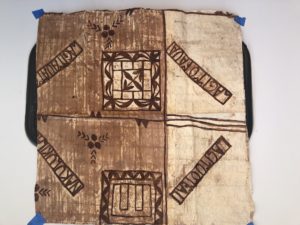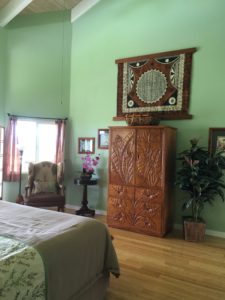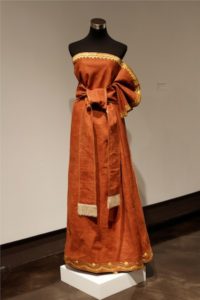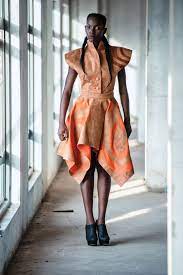And The Trees Clothed Us
by Cathy Koos
Back in the sixties, my Uncle Tom always wanted to invent paper clothes, and if he had figured out disposable diapers, he would have been a millionaire.
Paper clothes, however, have a worldwide ethnic history. Bark cloth or tapa or kapa comes from a forest ecology system, rather than an animal husbandry or crop-based tradition. Tapa artisans take the fine inside bast fibers of bark, wet and beat it into layers, not unlike wet felting of wool. By crisscrossing each layer, the fibers meld together creating a quite strong fabric.
On the Cook Islands and Samoa, the most common trees used were the dye-fig (Ficus tinctoria), which is endemic throughout Oceania. At some time, Paper mulberry (Broussonetic papyriferia) was introduced from Southeast Asia and overtook the dye fig as the fiber of choice.
I recently moved and came across this lovely vintage piece of tapa collected in Hawaii in the 1940s. Measuring about 30 x 30”, it was presumably a gift to my mother-in-law. Her father was a merchant marine during and after World War II and sent home all sorts of interesting finds.
A chat with my cousin, Diane, gleaned more information on this piece. She showed it to a Tongan acquaintance, Niva Scanlon (nivascanlonphotography.com) : …she is very involved in preserving and promoting Polynesian culture. She said it is a Tongan gatu. It is from the village of Lapaha in Tonga. It is part of a much bigger piece which must have included other site scenes. She said they don’t draw them like this anymore and it is a very old siapa.

Figure 1 Collection of Homer Mart
Prior to the introduction of European textiles like cotton, tapa was used primarily for garments but with the easy accessibility of cotton, tapa is reserved for special occasions like weddings, funerals, and decorative wall hangings, in this way keeping their cultural values close to hand.
After the inner bark is stripped and set aside, it is left to dry in the sun. When sufficient inner bark has been stockpiled, it is soaked in water. Then the beating of the fibers begins with coarsely grooved wooden mallets. As the fibers thin from beating, the strips are placed perpendicular to each other using some of the starch from the fibers to “glue” it together.
When a large piece of tapa is needed for a wedding or presentation, just like our American quilting bees, a group of women from the village gather to work a large tapa piece. The tap-tap of the mallets takes on a rhythmic beat that can be heard throughout the village.
Once the tapa large enough, it is time for painting. Traditionally, stencils were used with a brown paint from the koka tree.
This spectacular piece of tapa is from the collection of my cousin Diane Bundrant, and she believes it is Fijian in origin.

Figure 2 From the Collection of Diane Bundrant
Other forest-based economies also selected bast fibers for garments and coverings: in the central Sierra and coast regions, inner bark was harvested from the incense cedar and redwood trees. Parts of Africa use bark cloth for spiritual tools, including using as a shroud for a revered deceased community member.
And with a nod to Uncle Tom, here are a couple contemporary dresses.


National Geographic